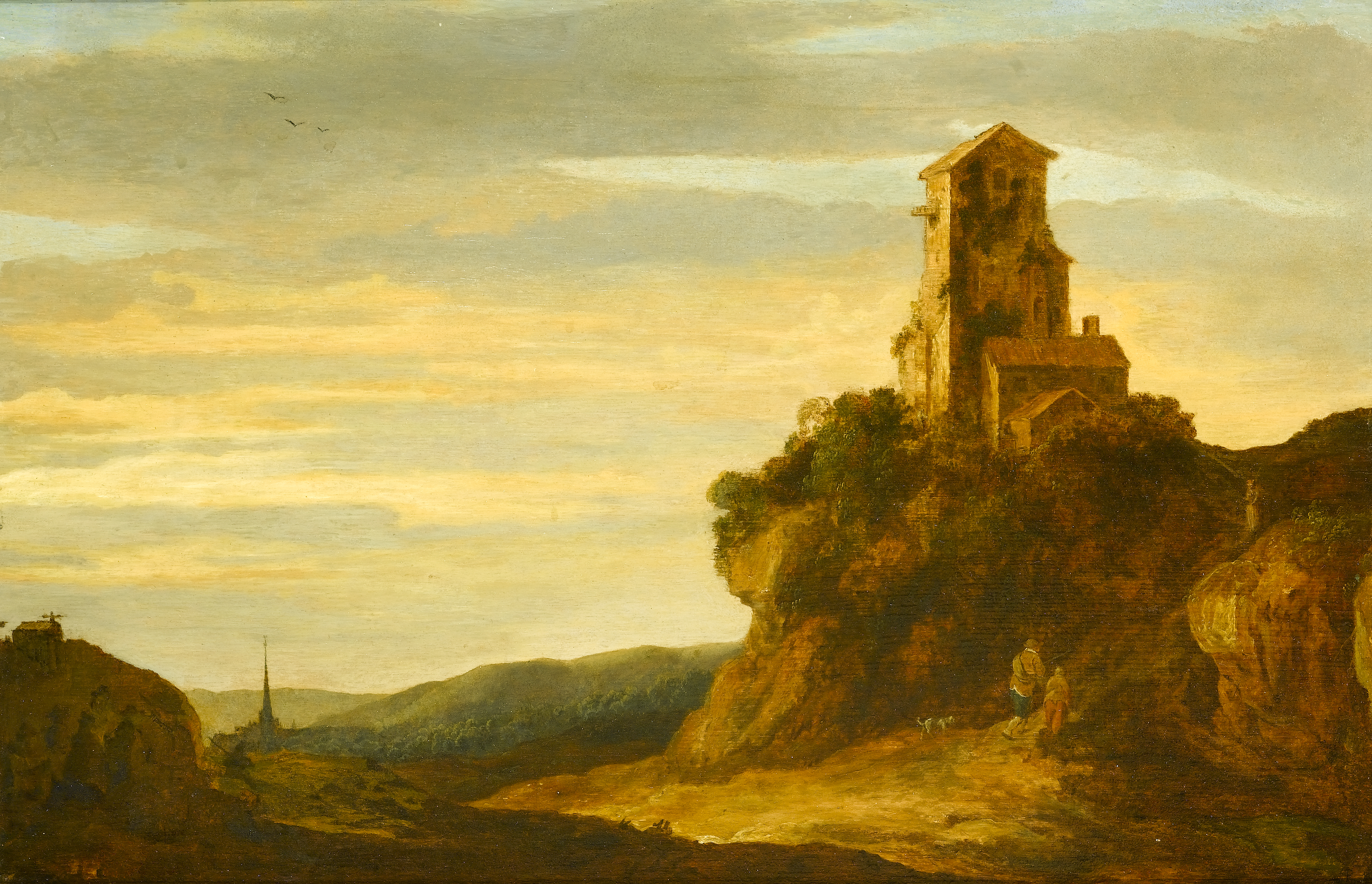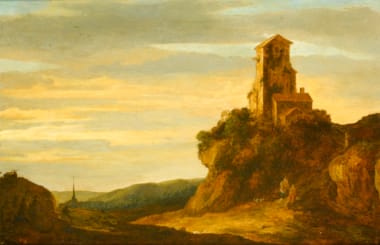
ieter de Molijn
(London 1595 - Haarlem 1661)
 Biography
Biography A Hilly Landscape with Wanderers at the Foot of a Castle Ruin
Biography
Pieter de Molijn was a Dutch painter, draughtsman and etcher of English birth and Flemish descent. His father, Pieter de Molijn, came from Ghent and his mother, Lynken van den Bossche, from Brussels. It is not known why they went to England, perhaps for employment rather than to avoid religious persecution. Pieter the younger apparently remained proud of his birthplace throughout his life, as can be inferred from his designation as ‘The Londoner’ in archival documents.
The earliest evidence of de Molijn’s presence in the Netherlands is his entry at the age of 21 into the Guild of St Luke in Haarlem in 1616, although no dated works by him before 1625 are known. Having apparently settled permanently in Haarlem, on 26 May 1624 he published his intention to marry Mayken Gerards, who also lived there. In the same year he became a member of the Dutch Reformed Church. Seven children were born to the couple between 1625 and 1639, not all of whom reached maturity. De Molijn was also a member of the Haarlem Civic Guards in 1624, 1627 and 1630. Throughout the 1630s and 1640s he held the office of Dean and Commissioner in the Guild of St Luke. In 1637–8 he was the guild’s alms collector. At his death he was buried in St Bavo’s in Haarlem.
De Molijn’s painted oeuvre can be divided into three distinct periods. During his early years, from 1625 to 1631, he employed an enormous variety of styles and subject-matter, including dune landscapes, travelling people and wagons, cavalry battles, ambushes, winter scenes, cottages among trees and conversing and reposing peasants. His figures are typically shown with long noses and masklike faces. His compositions range from the multi-figured Prince Maurice and Prince Frederick Henry Going to the Chase (The Stadholder is Going to the Chase) (1625; Dublin, National Gallery) to the simplified arrangement found in his Sandy Road (Dune Landscape with Trees and a Wagon) (1626; Brunswick, Herzog Anton Ulrich-Museum), in which de Molijn employed the dynamic diagonal composition that was to become his hallmark. The small Sandy Road panel also represents an early stage of the style known by historians as the ‘tonal phase’ of 17th-century Dutch painting, in which simple vistas of the countryside are characterized by a broad painterly manner and a restricted palette of greys, greens, browns, dull yellows and blues. These early paintings are characterized by a dramatic play of light and dark, at times using a spotlight effect to establish the focus of the picture.
De Molijn’s paintings from 1632 to 1647 have simpler compositions, with fewer figures, firmly integrated within the landscape. His foliage becomes denser, but overall his compositions are more spacious and expansive. Solemnity of mood and strong atmospheric effects permeate some of these paintings, and the light is more evenly diffused on the picture surface, with strong patches of local colour. Although de Molijn’s dated paintings of the 1630s are scarce, his output from the 1640s is prodigious. The high point of his career is the Peasants Returning Home (1647; Haarlem, Frans Halsmuseum), in which the monumentality of the composition may owe something to the influence of the young Jacob van Ruisdael. Yet the directness of expression, the forceful depiction of figures and the magnificent foliage are de Molijn’s own. In these years de Molijn’s compositional schemes also reflect the possible interchange of ideas with Salomon van Ruysdael and Jan van Goyen, although he did not prescribe to their full tonality.
During these middle years de Molijn was busy as a teacher of Gerard ter Borch and may also have had other students. He collaborated with ter Borch, Frans Hals and possibly with Pieter de Grebber, Jacob de Wet, Jacob Pynas and Nicolaes Berchem. De Molijn painted landscape backgrounds for their figure compositions, while in some instances they added figures to his landscapes. In his late years, from 1648, De Molijn produced numerous variations on previous compositions, refining their established stylistic and iconographic patterns. He shows more imagination in the elaboration and arrangement of his designs (e.g. River Valley, 1659; Berlin, Gemäldegalerie), possibly under the influence of the work of Hercules Segers. The thick impasto of the foreground may have been inspired by Rembrandt’s example (Stechow).
In 1625, the year of de Molijn’s first dated landscape painting, he also produced a series of four etchings depicting rustic and military figures set in landscapes with dilapidated huts in the manner of Abraham Bloemaert. These prints, de Molijn’s only firmly established work in the medium, are remarkable for his exploitation of the expressive possibilities of the blank sky, which is contrasted with the undulating patterns of the foreground. He also explores in them the same diagonal composition used a year later in the Brunswick painting. This format, with a high foreground on one side and a distinct panoramic view on the other, was taken over by generations of later Dutch landscape painters.
De Molijn was a prolific landscape draughtsman, particularly in his later years. His earliest drawings, in pen and ink are similar to the graphic style of his etchings and have been compared to the landscape drawings of Jan II van de Velde, Hendrick Goltzius and Jacques II de Gheyn. Most of his drawings, however, are executed in black chalk with grey wash. They are almost invariably signed, and most are dated, the majority in the 1650s.
De Molijn’s work encompassed elements of both fantasy and reality. He was a transitional figure in the history of Dutch landscape painting whose oeuvre formed a bridge between the manneristic devices of the previous century and the new naturalism of the 17th century. He integrated both extremes in his art in an imaginative and individualistic manner. One of his contributions is the sensitive and keenly observed way in which he depicted the contemporary rural life of the Netherlands and its inhabitants. Although his figures are rather weakly drawn throughout his career, they are an important and integral part of his compositions.
De Molijn was appreciated as an outstanding artist in his own lifetime by Samuel Ampzing and Theodor Schrevelius. Although Houbraken later devoted only a short paragraph to De Molijn, his name found its way into the influential 18th-century dictionaries. In the 19th century Adam Bartsch established the artist as a fine printmaker, while van der Willigen uncovered archival evidence of his life and art. Only since the mid-1960s, however, hasd Molijn come to be recognized as one of the leading figures of early 17th-century Dutch landscape art along with Esaias van de Velde and Jan van Goyen.
Collections
Molijn is represented in the following collections: Rijksmuseum, Amsterdam; Frans Hals Museum, Haarlem; Museum Bredius, Netherlands; Courtauld Institute of Art, London; The Louvre, Paris; Royal Museums of Fine Arts, Brussels; Metropolitan Museum of Art, New York J. Paul Getty Museum; Fitzwilliam Museum at the University of Cambridge; Detroit Institute of Arts, Michigan; Fine Arts Museums of San Francisco; Museum of Fine Arts, Boston; National Gallery of Art, Washington D.C.; Block Museum of Art at Northwestern University, Illinois; Harvard University Art Museums, Massachusetts, amongst others.









